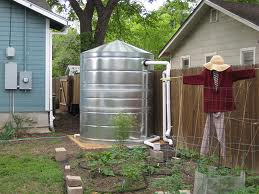 Water is an incredibly important resource. Without ready access to it, we die. Water, theoretically, is a renewable resource, at least, before the specter of climate change became discernible. With some simple design, we can harvest the water we get in the form of rain to reuse. We can use in irrigating plants, or, in emergency situations, we may purify it to drink.
Water is an incredibly important resource. Without ready access to it, we die. Water, theoretically, is a renewable resource, at least, before the specter of climate change became discernible. With some simple design, we can harvest the water we get in the form of rain to reuse. We can use in irrigating plants, or, in emergency situations, we may purify it to drink.
Rainwater catchment is sometimes used with home-scale wetlands, in order to maximize the total amount of water one’s property can store. It’s an incredibly easy practice to get into and one with great potential to adapt into more complicated systems, as you see fit.
Let’s take a look at some simple rainwater catchment systems.
Why Rainwater Catchment
Worldwide, in areas where regular access to water is not a given, rainwater catchment ensures people’s survival. In urban areas, it can be a contingency plan against the interruption of a city’s water system’s function, say, if mains were to rupture during an earthquake. Some cities sited on rivers also have combined sewage systems, meaning that rainwater run-off is channeled into the sewer during storms. This often overloads the sewer and causes human waste to back up into aquifers.
At any rate, from an ecological standpoint, storing water on one’s own property ensures a ready supply of it that doesn’t have to be drawn from somewhere else. Whether you live in a region with lots of rainfall, or an area that experiences drought or an overtaxed water table, grabbing the water that generally in available naturally is a great move towards conservation.
Take Caution
Don’t subscribe to wishful thinking when it comes to harvesting and reusing rainwater. If it’s harvested from your roof, it may contain trace particles of tar, mercury from industrial pollution, or bird feces. You could get very sick, or harmful things you wouldn’t want in your body could accumulate. Harvested storm water has its specific purposes. Don’t get all crazy because of the possibilites. Always treat your rainwater and make sure its clean if you intend to drink it.
Basic Parameters
A basic rainwater catchment system would collect rain run-off from one’s roof. The run-off is then channeled through the gutters on one’s roof. The gutters then channel the rainwater into storage tanks, often running through filters to make sure sediment or contaminants don’t accumulate in the storage tanks. The tanks often have overflow pipes to prevent system back-up and screens to prevent mosquitoes from nesting, or unwanted matter from falling in. From there, the collected water could be channeled to a storage pond, such as a yard-sized aquatic area. Or, if there’s a spigot on the collection barrels, the spigot can be attached to a hose to used for irrigation. Or the water can be channeled through further tanks and filters, until it can be channeled to safely use indoors.
In Brazil, for example, collected rainwater is treated with alum and chlorine before it is reused. In other areas, solar rainwater sterilization techniques are used, such as boiling the water in solar cookers. This process will kill harmful bacteria and other pathogens, but will not purify the water. Allowing water to run through your system, without collecting it initially after a dry spell, is a way to make sure that unwanted contaminants aren’t concentrated in your collected rainwater.
A simple solar disinfection model is collecting water in clear plastic soda bottles and laying them on a flat surface that will collect sunlight. Water should be exposed for six hours, at minimum, or for two days, in cloudy conditions. The UV-A rays from sunlight will kill pathogens and cumulative solar energy will heat the water, hastening the process. This is the cheapest and easiest method.
For much more information regarding rainwater catchment, visit http://www.rainwaterharvesting.org/.

